These high-performance educational buildings encourage connectivity and experiential learning.

Photo by Albert Vecerka/Esto
Buzz Yudell, urban planner and cofounder of Moore Ruble Yudell, brought Carnegie Mellon University’s vision of interconnectedness to life with the new Tepper Quad Project.
“It begins with the campus and the School of Business committing to a project that goes well beyond the school of business to foster integration, collaboration, and experimental teaching on many levels,” Yudell says. “The experience of the building was developed to build upon the idea of breaking down barriers and enhancing collaboration, even between the university and its neighborhood and the community at large.”
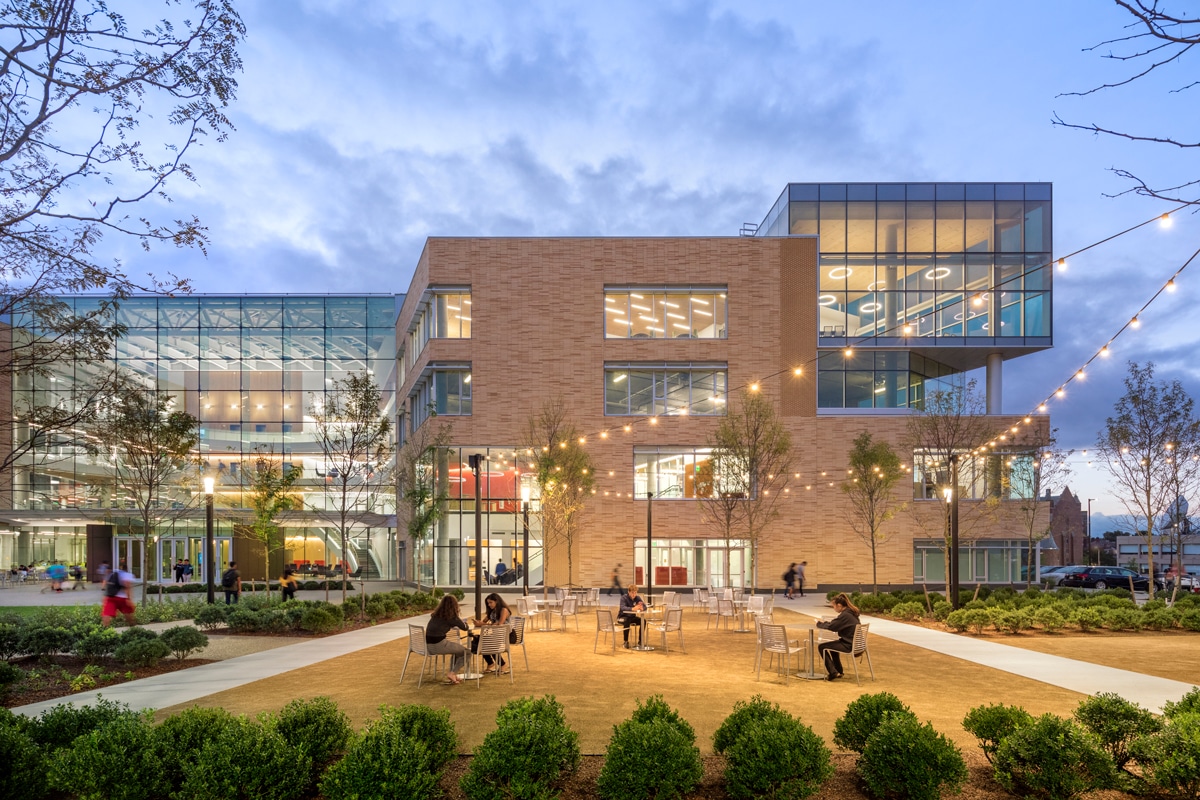
Locally sourced bricks from Beldon Bricks have a modern, sleek design that complements the campus’s long-standing traditional look. Photo by Albert Vecerka/Esto
Traditionally business schools dwell in their own sort of bubble on college campuses, but the Tepper Quad sought to enhance collaboration and blend the school of business with all disciplines. With a mix of spaces like an office for students with startup businesses, breakout spaces for meetings or group study, and private kiosks akin to telephone booths, the new business school has more of an experimental, first job feel than you might see in traditional university halls.
You’ll find areas for independent work, but the design was intended to work as “a very flexible, fluid network of spaces rather than a strict hierarchy of defined spaces,” Yudell says. Almost all rooms are adaptable. The 600-seat Simmons Auditorium, for example, has retractable theater-quality seating and acoustic partitions that allow the space to be reconfigured into several smaller spaces.
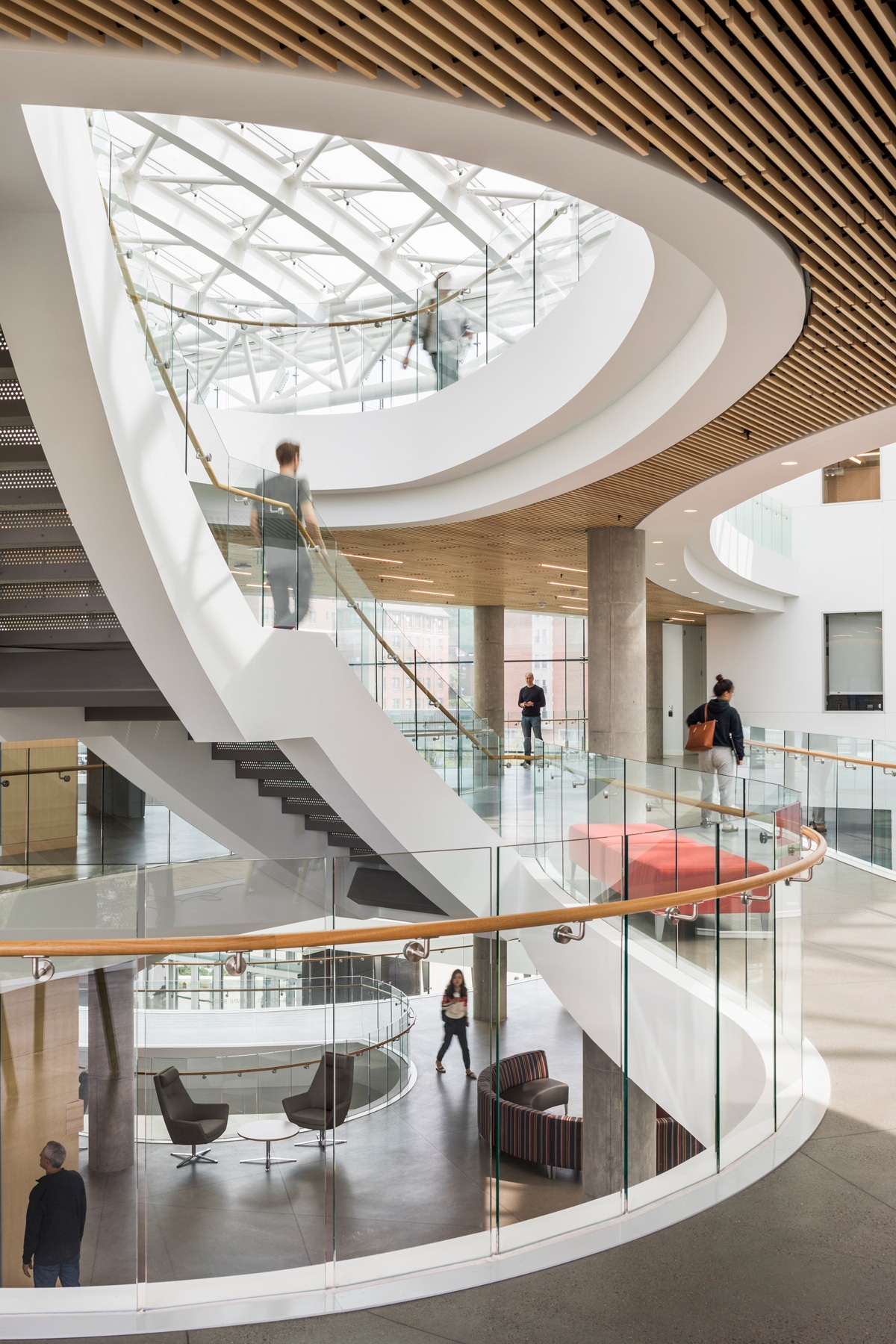
Photo by Albert Vecerka/Esto
One unique sustainable aspect of the building is the voided slab technique created with 9-, 10- and 12-inch spheres from Bubble Deck. The spheres are manufactured from recycled kayaks and reduce floor thickness, allowing for smaller foundations and columns.
“After testing several systems, it became clear that to do a fully concrete slab and structural system would allow us to expose most of the ceilings, most of the floors, and almost all of the structure,” Yudell says. The voided slab was the largest to date when Tepper Quad opened. It reduced construction cost by 10% and cut the building’s total height by several feet without reducing the volume occupied.
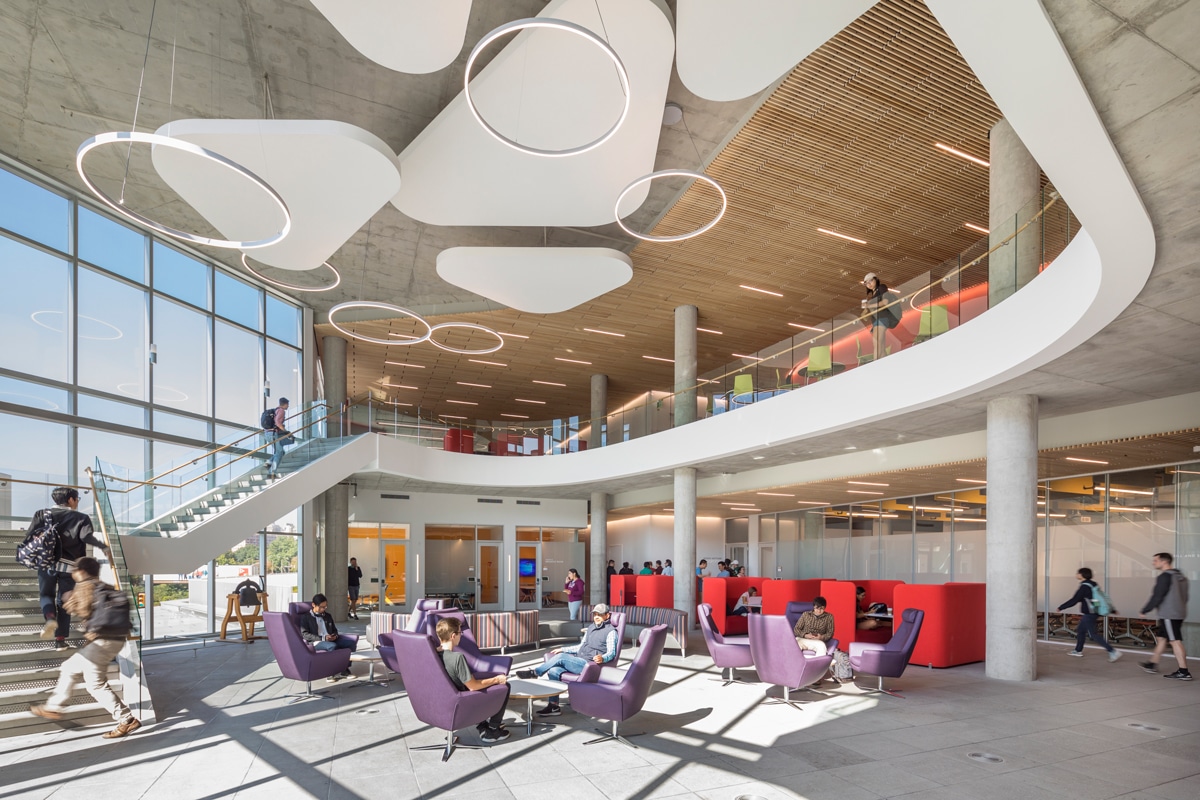
Photo by Albert Vecerka/Esto
Yudell and his team sought to make the experience of the Tepper Quad uplifting. The project includes areas that connect to outdoor spaces so students can work and experience the seasons at the same time. The building also has a fitness center, bike storage, and a café with healthy food options.
“Sustainability was integrated with health and wellness, which is one of the things we are all pleased about. The building has become a magnet for students, faculty, staff, and the greater community,” Yudell says.
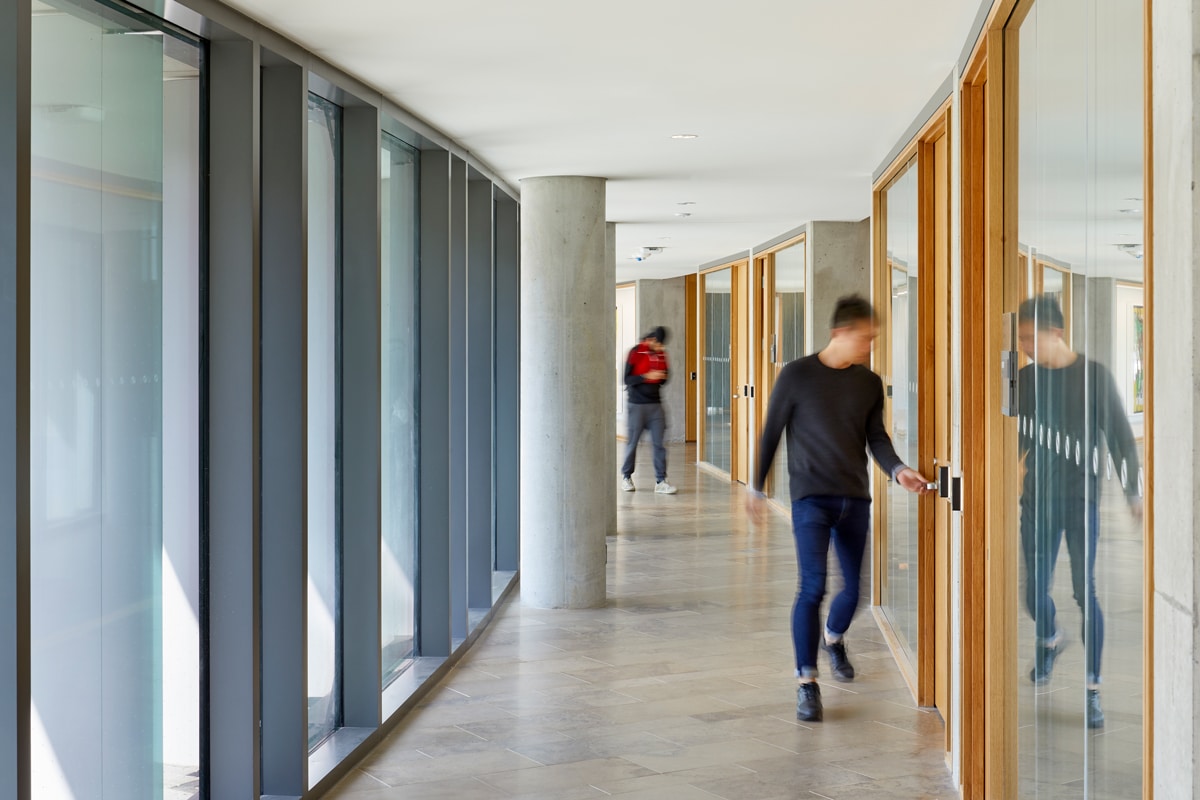
BSN Architects’ design for the Rob and Cheryl McEwen Graduate Study & Research Center focused on reconfigurable spaces and community areas. Photo by Tom Arban
Carnegie Mellon University’s Tepper School of Business isn’t the only business school obtaining significant marks in sustainability. Barry Sampson, principal architect at Baird Sampson Neuert, employed his long-standing interest in bioclimatic design for his work on the Rob and Cheryl McEwen Graduate Study & Research Center at York University. His firm has been interested in climate and biological responsive design for many years, and Sampson says their work on a butterfly conservatory nearly 25 years ago really focused their minds on how a building has to maintain a certain environment for living creatures.
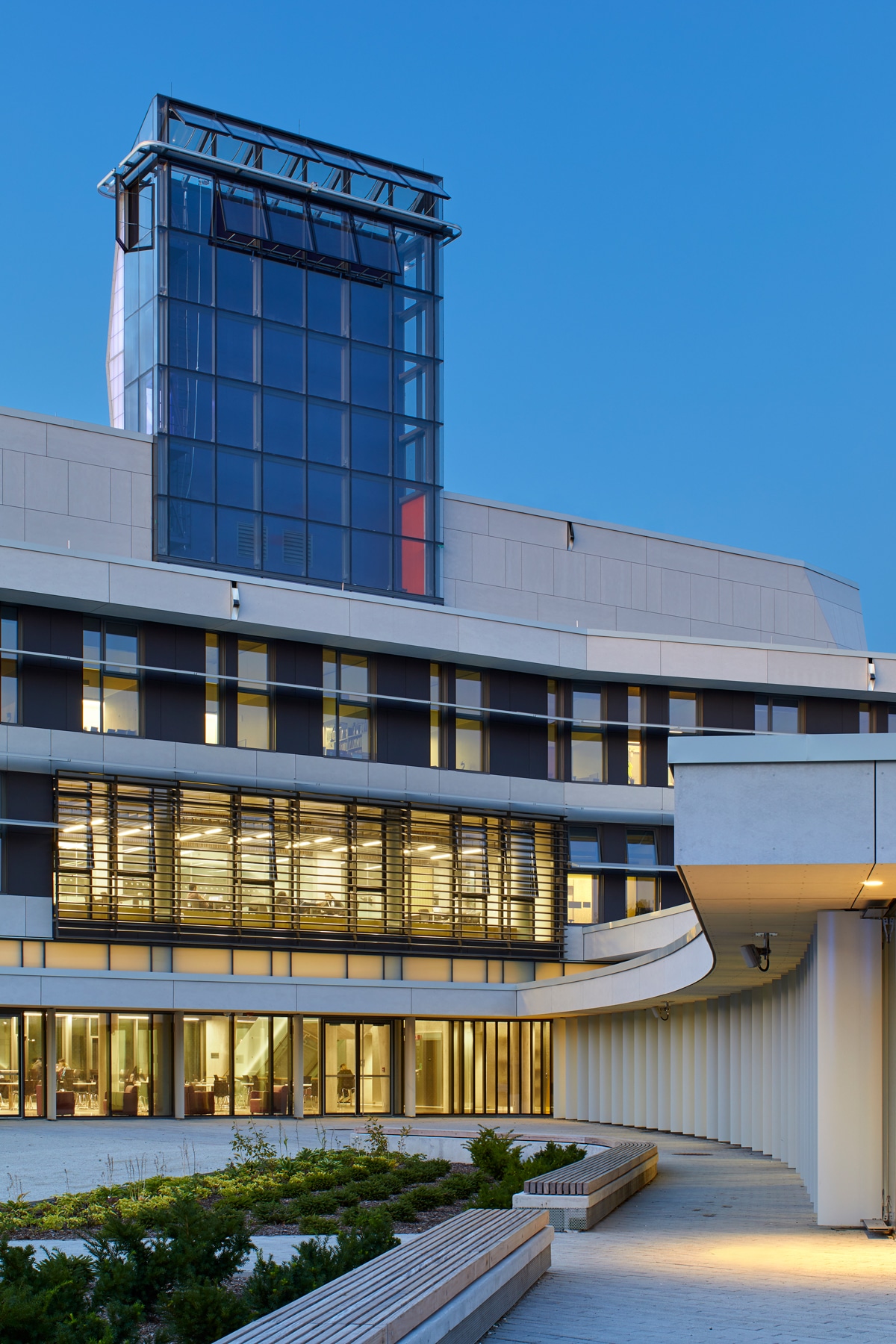
The solar chimney extends nearly seven stories high and induces stack effect ventilation. Photo by Tom Arban
“We’re very interested in buildings that promote biological well-being, and we’re very interested in buildings that reduce their burden on the environment,” he says. The team’s focus was reflected in the McEwen Graduate Study & Research Center’s high-performance design.
In addition to meeting York University’s sustainability concerns, Sampson’s design fits the school’s advanced curricula with reconfigurable spaces that allow creative and spontaneous interaction between educators, students, and peers. The central atrium has the digital technology needed for top public events and is set up with tables and lounge furniture for informal meetings. It serves as a sort of gathering place for students to linger with peers, make spontaneous connections with faculty, or study on their own.
“Off one of the corridors there’s a ledge where you can sit and do some brief work,” Sampson says. “We’re always thinking about ways in which people can be encouraged to linger if they want to and have opportunities to meet either their peers, students, professors, or colleagues.”
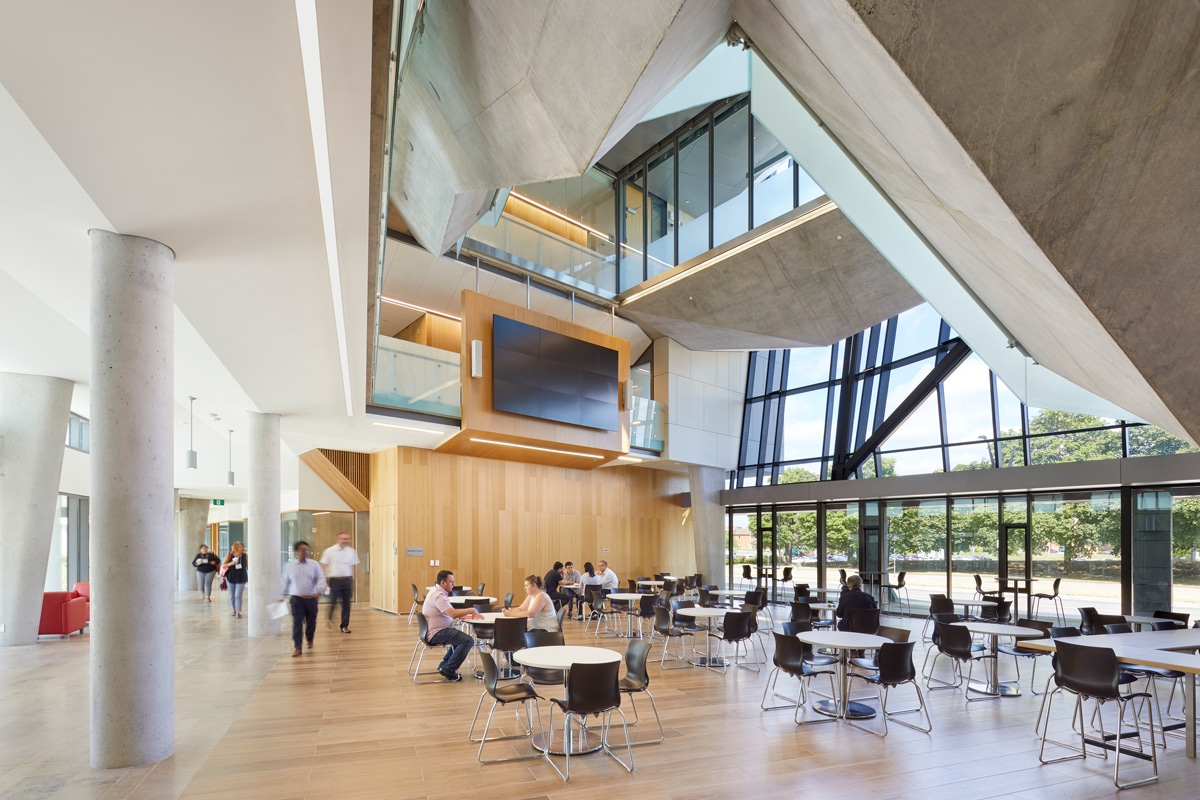
Photo by Tom Arban
The McEwen Graduate Study & Research Center was originally intended to be a mixed-use academic building with a residential area above classrooms, offices, and labs, but changes in university policy required the team stick to a strictly academic design. Still, even after reverting from the original plan, Sampson’s early rendition for a nearly 92-foot solar chimney that induces stack effect ventilation remained a key element.
“This is the second tallest solar chimney in Canada that we’re aware of,” he says. “When it was determined the residence would be provided elsewhere on campus, we had a discussion with our client about the value of retaining the solar chimney.” The solar chimney exaggerates effective ventilation in the three floors of classrooms and offices. Where a typical building may be able to use natural ventilation for 52 days of the year, the solar chimney, along with other bioclimatic design elements like intentionally sized windows, extends natural ventilation for 160 days.
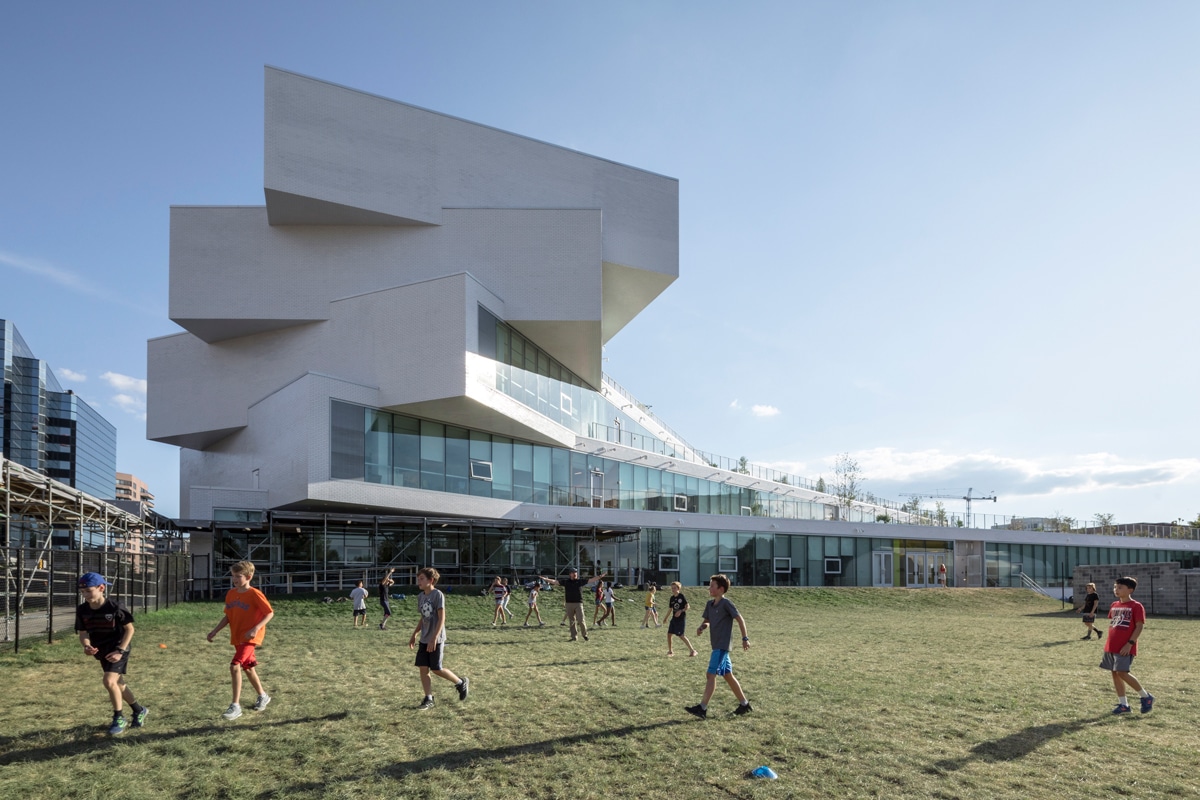
Five rectangular platforms create continuous space that extend the learning scape and encourage connectivity. Photo by Laurian-Ghinitoiu
Interconnected learning spaces are also making their way into public school systems. Daniel Sundlin, partner at Bjarke Ingels Group, worked closely with students and teachers to design The Heights, a new secondary school in Arlington that houses the H-B Woodlawn Program and the Eunice Kennedy Shriver Program.
H-B Woodlawn’s studies focus on visual and performing arts while Shriver provides extensive resources for students with specialized educational needs. Bringing the programs together required a design with a sense of connectivity that still allowed different programs to work within their own spaces. “We had a lot of meetings early on in the process where we shared a lot of ideas,” Sundlin says. “For me, what was really special was the close relationship built between the team and the tenants. It’s been a very fun and educational journey in many ways.”
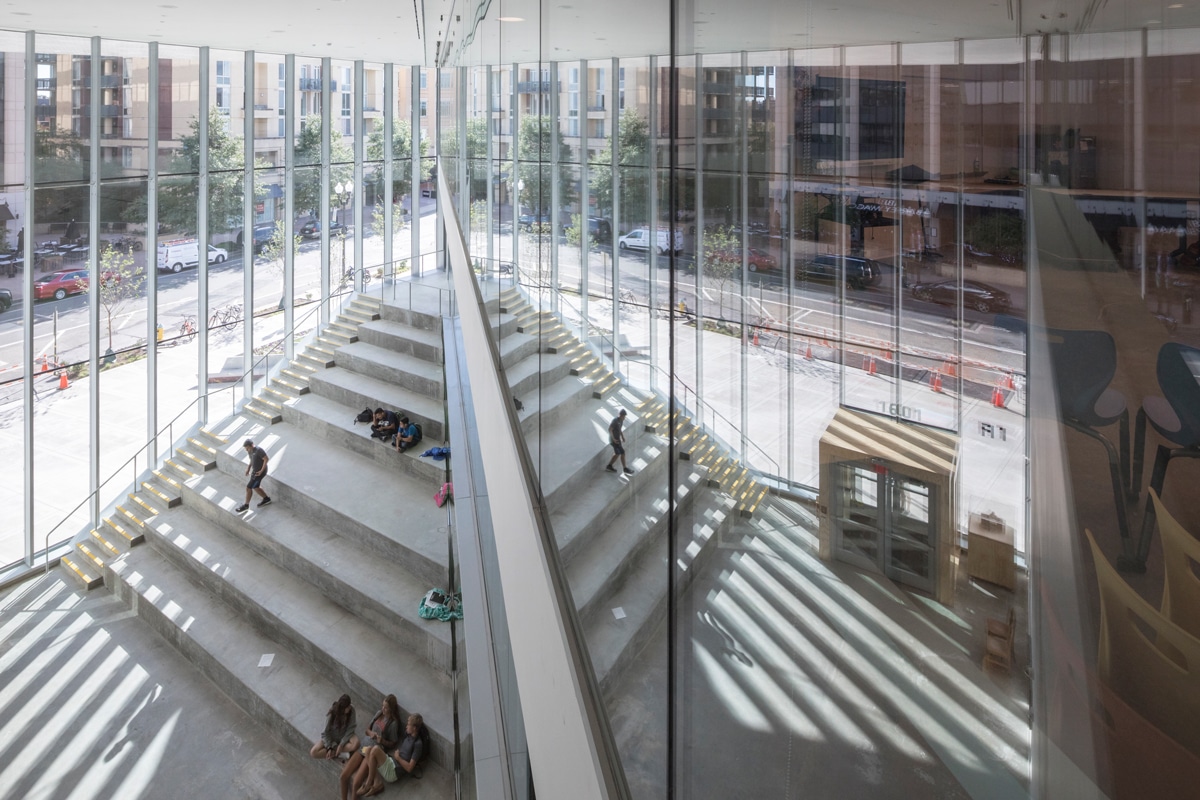
Photo by Laurian-Ghinitoiu
Working within a strict budget and limited space, Sundlin designed roofscapes that offer untraditional learning spaces and a hybrid of functions. “Since the site was so small, we knew early on that we needed to provide sufficient outdoor space,” he says. The terraces are designed with H-B Woodlawn students’ sovereignty in mind and encourage them to venture outside. Terraces on the upper floor are intimate and quiet to accommodate independent study while terraces on the lower level are open and community-driven to promote connectivity between students.

Photo by Laurian-Ghinitoiu
For the Shriver Program, Sundlin considered students’ sensitivities to light and commotion as well as accessibility needs. Features like recreational areas and a sensory cottage are located on the first two floors, accessible from the ground. “We wanted to make sure there was a relationship between the two programs,” Sundlin says. “The sort of cascading stair in the middle of the building terminates in the Shriver program, so they both have privacy, but they are both very much a part of the daily life in the school.”
The Heights features an on-site rainwater system, high-performance glazing, LED lighting with sensors and dimming capabilities, and an 18,700-square-foot vegetated roof. It is expected to receive LEED Gold certification.
Project Details
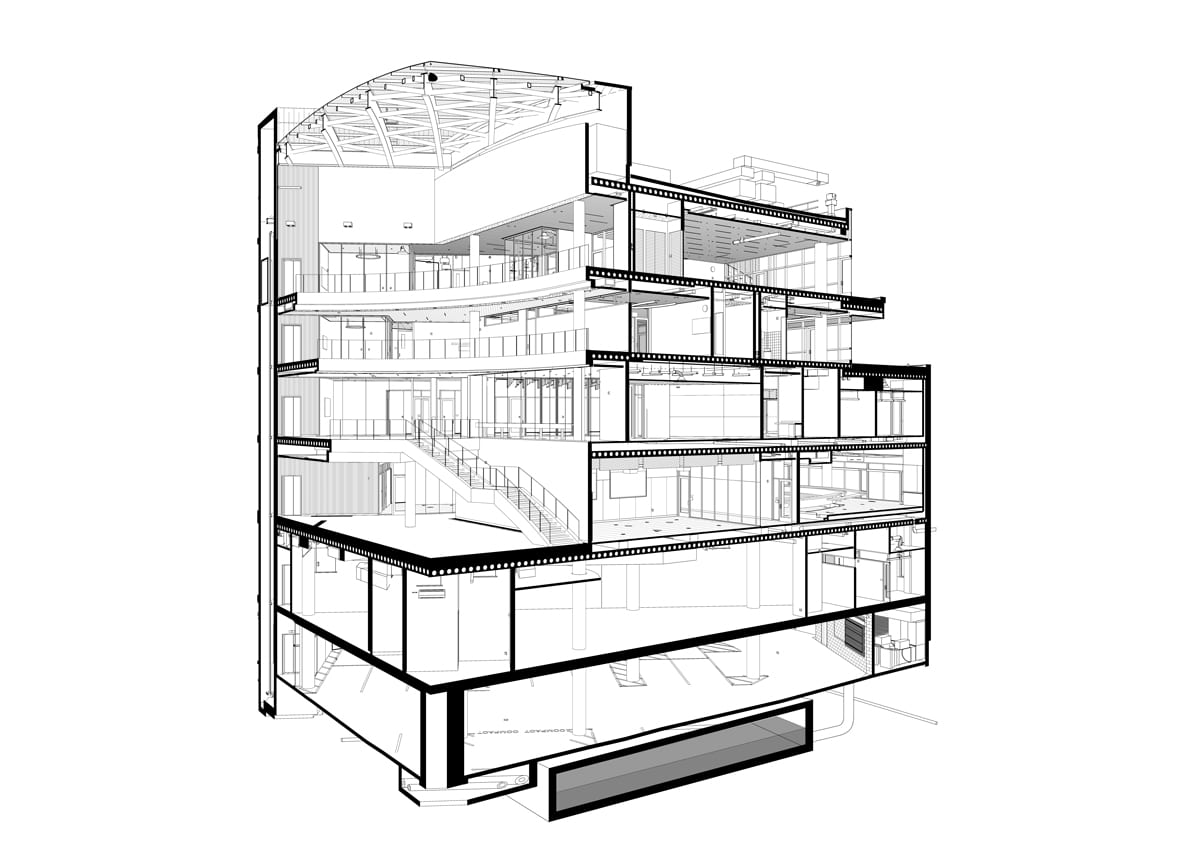
Drawing courtesy of Moore Ruble Yudell
Project: Tepper Quad Location: Pittsburgh, PA Completion: August 2018 Size: 315,000 square feet Cost: $201 Million Lead Architect: Moore Ruble Yudell Architects & Planners Associate Architect: Renaissance 3 Architects Engineer: BuroHappold Construction Manager: P.J. Dick Landscape Architect: Sasaki
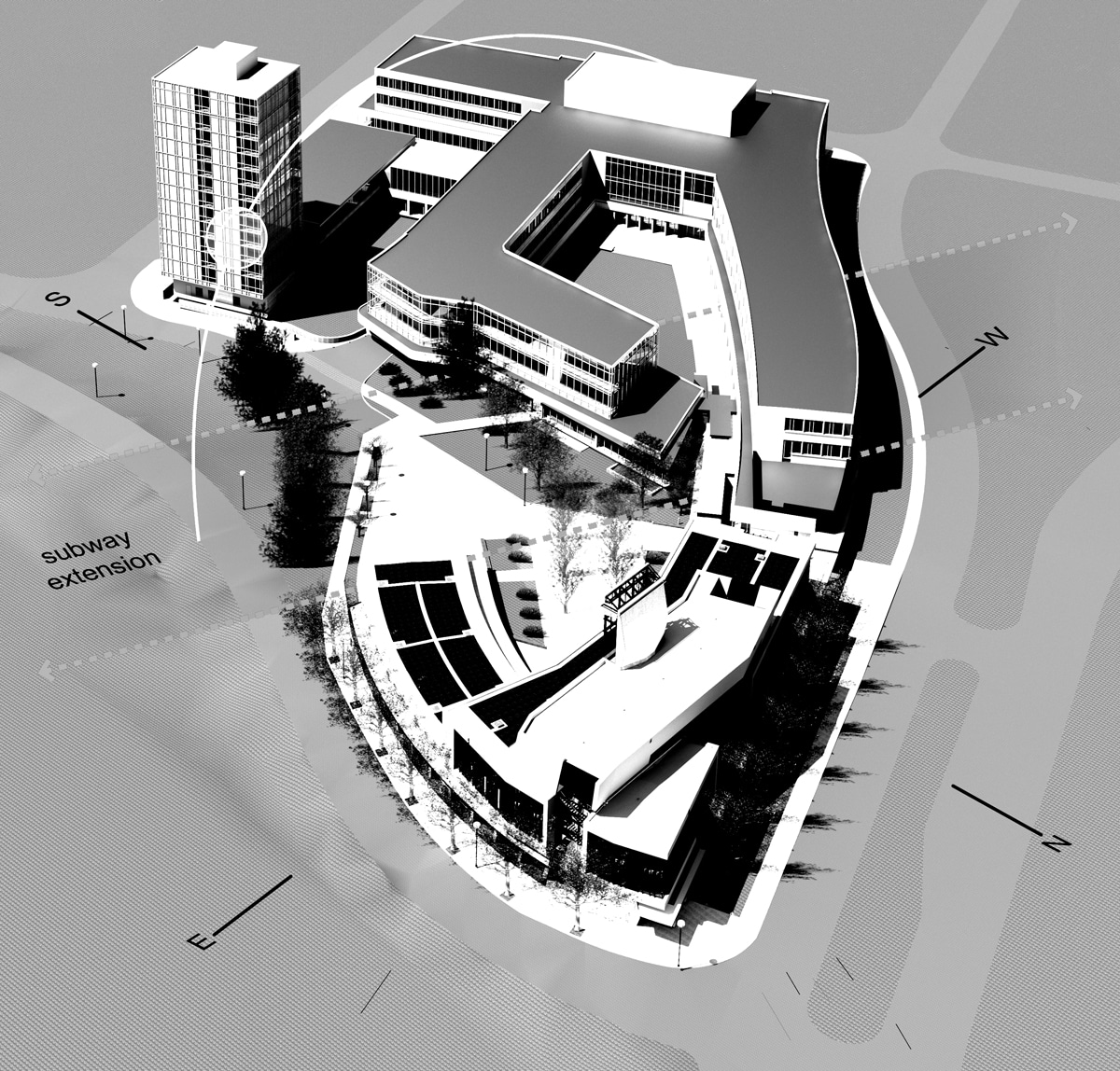
Drawing courtesy of BSN Architects
Project: Rob and Cheryl McEwen Graduate Study & Research Center Location: Toronto, Canada Completion: 2019 Size: 66,360 square feet Cost: $40 million Lead Architect: Baird Sampson Neuert Architects Structural Engineer: Blackwell Structural Engineers Mechanical Engineer: Crossey Engineering Ltd. Electrical Engineer: Crossey Engineering Ltd. Landscape Architect: Plant Architect Contractor: Ellis Don Climate Engineer: Transsolar Klimaengineering Civil Engineer: RV Anderson Acoustics: Swallow
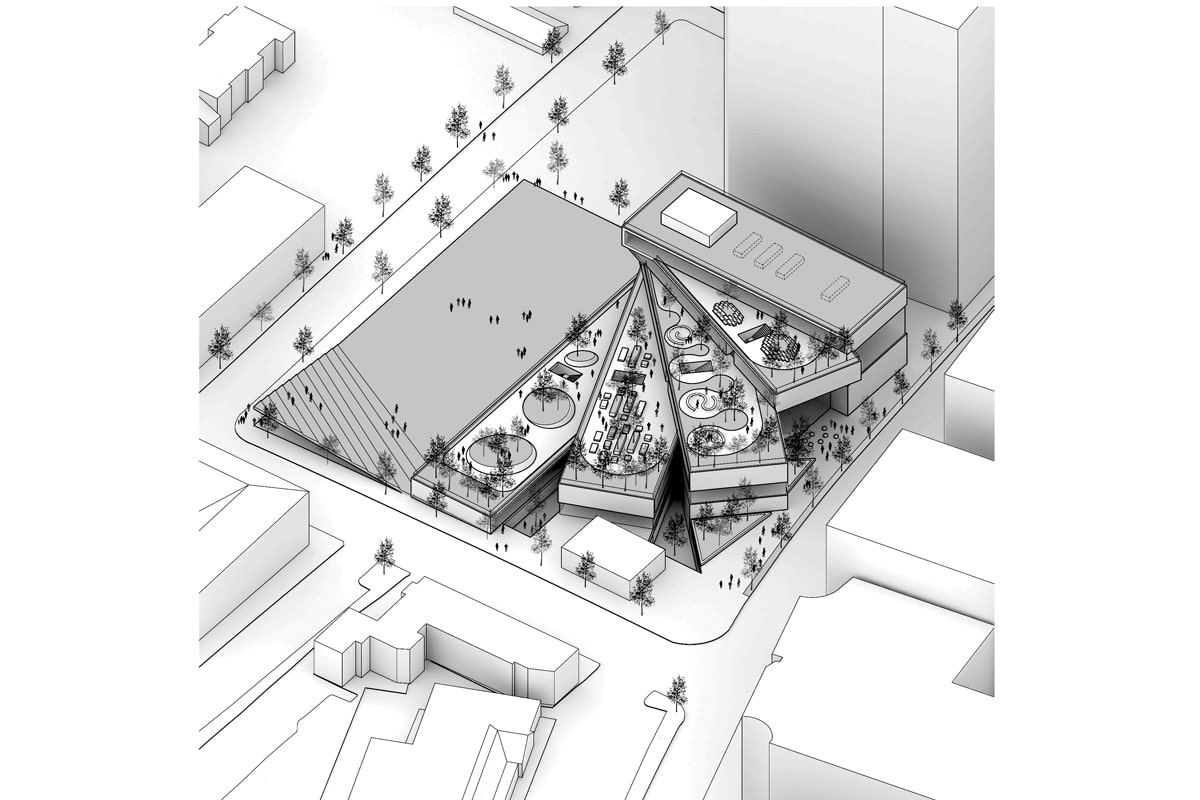
Drawing courtesy of Bjarke Ingles Group
Project: The Heights Location: Arlington, VA Completion: October 2019 Size: 54,790 square feet Architects: Bjarke Ingels Group, LEO A DALY Environmental Engineer: EHT Traceries Sustainability: Sustainable Design Consulting

